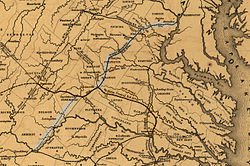Orange and Alexandria Railroad

1852 map showing the O&A
|
|

The engine "Firefly" on a trestle of the Orange and Alexandria Railroad.
|
|
| Locale | Virginia |
|---|---|
| Dates of operation | 1848–1867 |
| Successor | Orange, Alexandria and Manassas Railroad |
| Track gauge | 4 ft 8 1⁄2 in (1,435 mm) standard gauge |
| Previous gauge | Originally built as 4 ft 8 in (1,422 mm) |
The Orange and Alexandria Railroad (O&A) was a railroad in Virginia, United States. It extended from Alexandria to Gordonsville, with another section from Charlottesville to Lynchburg. The road played a crucial role in the American Civil War, and eventually became an important part of the modern-day Norfolk Southern rail system.
The Virginia General Assembly issued a charter to the O&A on May 28, 1848, to run from Alexandria to Gordonsville. Construction began in 1850 and was completed in April 1854, when it connected with the Virginia Central Railroad in Orange County. Its longtime President was John S. Barbour Jr., Virginia lawyer, part-time delegate and son of U.S. Representative John Strode Barbour.
In 1854, the General Assembly granted the O&A the right to build southward from Charlottesville to Lynchburg. O&A paid for trackage rights over Virginia Central tracks from Gordonsville to Charlottesville. In 1860, the southern extension was completed, including lucrative connections to the Virginia and Tennessee Railroad and the South Side Railroad. The O&A also connected with the Manassas Gap Railroad (chartered in 1850), at Tudor Hall (today named Manassas for this junction) which gave it access to the Shenandoah Valley.
The railroad boosted Virginia commerce. Farmers from first Virginia's Piedmont region, and later the Shenandoah Valley could ship their products, produce and goods much more cheaply than before. Not only were the markets of Washington D.C. and Richmond, Virginia accessible, so was the Potomac River port of Alexandria (accessible to ocean-going vessels). Alexandria, Richmond and Lynchburg also became manufacturing centers. Passengers could travel from Washington to Lynchburg in eight hours instead of enduring a three-day stagecoach journey.
...
Wikipedia
